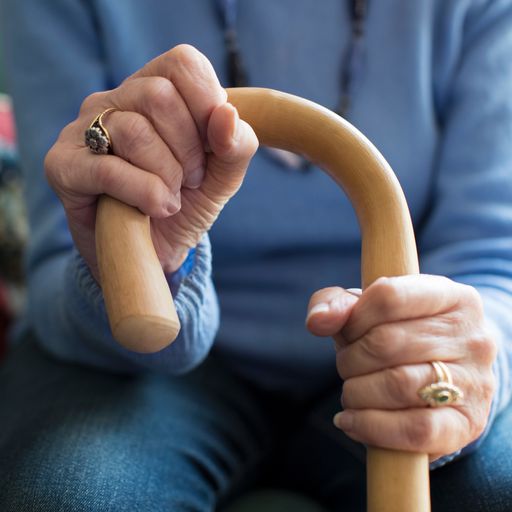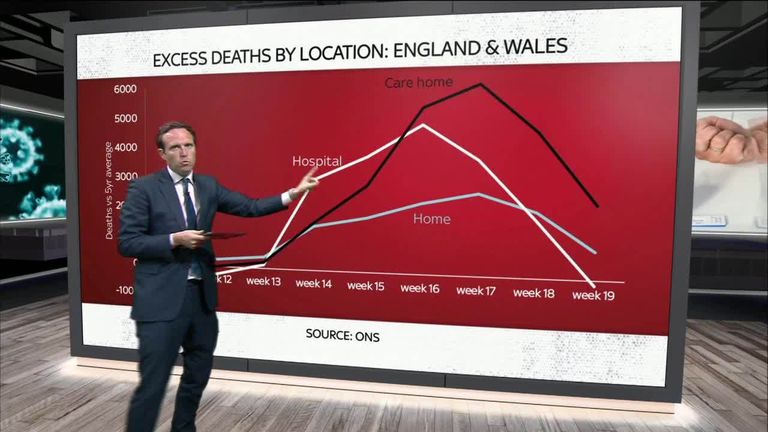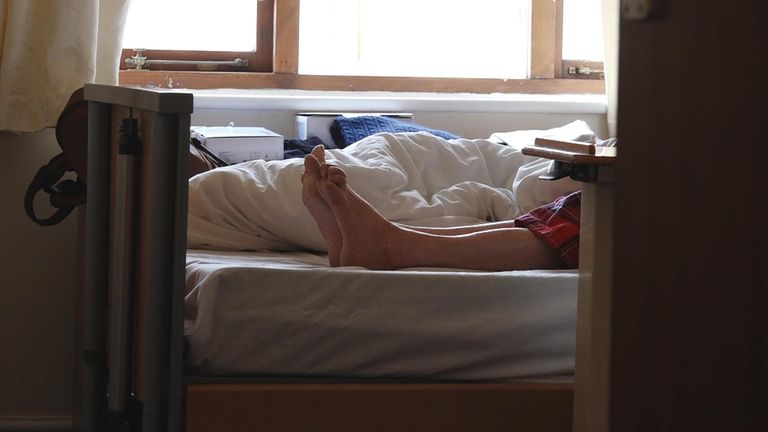Coronavirus: The number of 'excess deaths' in care homes and hospitals compared with normal times is revealed
More than twice the number of deaths have been recorded in care homes in England and Wales this year compared with the average.
Wednesday 20 May 2020 15:21, UK
Twice as many people have died in care homes in England, Wales and Scotland during the coronavirus pandemic than would be expected in normal times, Sky News analysis has found.
Between 13 March and 8 May, 39,404 people died in care homes in England and Wales.
The five-year average number of people who die in care homes during that same period is 17,591, according to the Office for National Statistics (ONS).
This means an extra 21,813 deaths occurred between what the ONS record as week 12 and week 19, a rise of 124%.
Figures from the ONS and National Records of Scotland (NRS) show there have been 11,414 deaths involving COVID-19 recorded in care homes.
This includes when coronavirus is suspected, as well as when the patient has tested positive for the virus.
But only looking at the people who have COVID-19 listed on their death certificate does not show the true picture of what is happening in care homes.
A better measure is "excess of mortality", a term used to describe when more people die than would be expected under normal conditions.
:: Listen to the Daily podcast on Apple Podcasts, Google Podcasts, Spotify, Spreaker
Some of the people who died from coronavirus may have died anyway from another health problem. However, by looking at the excess of mortality figures we can get a better understanding of the impact of the pandemic.
The excess of mortality figure also takes in deaths of people who have died as an indirect result of the pandemic, such as if a diversion of resources led to the person passing away.
Although there are no figures available for Northern Ireland, overall deaths in Scottish care homes are also double the five-year average.
There have been 2,054 additional deaths in care homes there, with 4,070 people dying compared to the 2,016 previous average, according to the NRS.
These figures cover the deaths registered in care homes during almost the same time period as the England and Wales figures, with the Scottish figures going from week 12 (16-22 March) to week 19 (4-10 May).
Chairwoman of the National Care Association, Nadra Ahmed, believes there are many reasons why there has been such a big rise in the number of excess deaths.
She told Sky News: "We are in a pandemic [and] there has been some fairly chaotic guidance and very little clinical support."
She says that when residents feel unwell in normal times, a GP would be called and health support would be provided to ensure the patient has a good chance of recovery.
But this has become difficult, with Ms Ahmed highlighting a case where a consultation from a GP had to be done via an iPad, which meant a physical examination couldn't take place.
Additionally, she has concerns that some residents may have fears about going into hospital because of the virus, so might try to hide that they feel unwell - something that is compounded by a stretched staff team who don't have as much time to notice such signals.
"People may not be addressing those issues [of feeling unwell]. Those who are compos mentis might think, 'I don't want to get involved in all this, I'll just keep quiet, I can manage this'.
"I don't want to play a blame game here but this is about not having the normal levels of primary care support that [care homes] would normally have," she says.
She continues: "I think staff will have been crisis managing.
"Here we have a situation where the staff are trying to not only be the coalface of delivering personal care but also the social and the mental health care that they can."
Ms Ahmed says there are "multiple factors of this virus being so dangerous for older people", highlighting the example of the difficulties of getting a person with dementia to self-isolate or remember to wash their hands regularly.
She also raises that, especially for older people, stress and fear can have a big impact on people's minds and bodies.
Excess deaths are happening in both care homes and in hospitals, but the number of excess deaths is higher in care homes.
The total number of deaths registered between weeks 12 and 19 in hospitals in England and Wales is 40% higher than expected.
There were 15,787 additional deaths: 54,862 deaths compared to the 39,075 five-year average.
Almost half of these hospital deaths had COVID-19 on the death certificates.
Meanwhile in Scotland, there were 548 additional deaths in hospitals between the weeks 12 and 19. This is 13% higher than the expected numbers.
Of the 4,871 people who died during that period in Scottish hospitals, a third of them were recorded as COVID-19-related.
A Department of Health and Social Care spokesperson said: "Every death from this virus is a tragedy and our deepest sympathies go out to the families who have sadly lost relatives.
"Supporting the social care sector throughout this pandemic is a priority. We are working around the clock to give the social care sector the equipment and support they need.
"We are ensuring millions of items of PPE are available to care workers, using our increased testing capacity to test care home residents and staff regardless of symptoms, and introducing our new £600m infection control fund to help prevent the spread in care homes."
Analysis: Equivalent of at least one in 10 of the care home population have died during the pandemic
By Ed Conway, Sky News economics editor
The number of care home residents who have died during the COVID-19 outbreak is now equivalent to at least one in 10 of the entire care home population, according to Sky News analysis.
Between early March and the first week of May, nearly 54,000 care home residents have died in England, Wales, Scotland and Northern Ireland.
The number includes deaths from all causes, and while only a fraction are formally attributed to COVID-19, the cumulative total is now well over double the historical average for deaths at this point in the year.
Since the total number of beds in the care sector across the UK is 532,000, it means that more than 10% of the care home population has died since March.
This calculation is a cautious one, since at any point the care sector typically has a below 100% occupancy rate.
Plus, while the 54,000 deaths include just under 6,000 care home residents who died in hospitals, they also under-count the total number of care home deaths in Northern Ireland, since those statistics aren't provided by its statistical office.
The figures are the latest evidence of how severely the epidemic and lockdown have hit the care sector, where the number of excess deaths are higher than in hospitals or any other setting.
The word "decimate" is often misused. Strictly speaking, it means to eliminate one in 10 of a given figure.
It is perhaps one of the most depressing outcomes of the epidemic that during this outbreak, Britain's care home population has literally been decimated.







